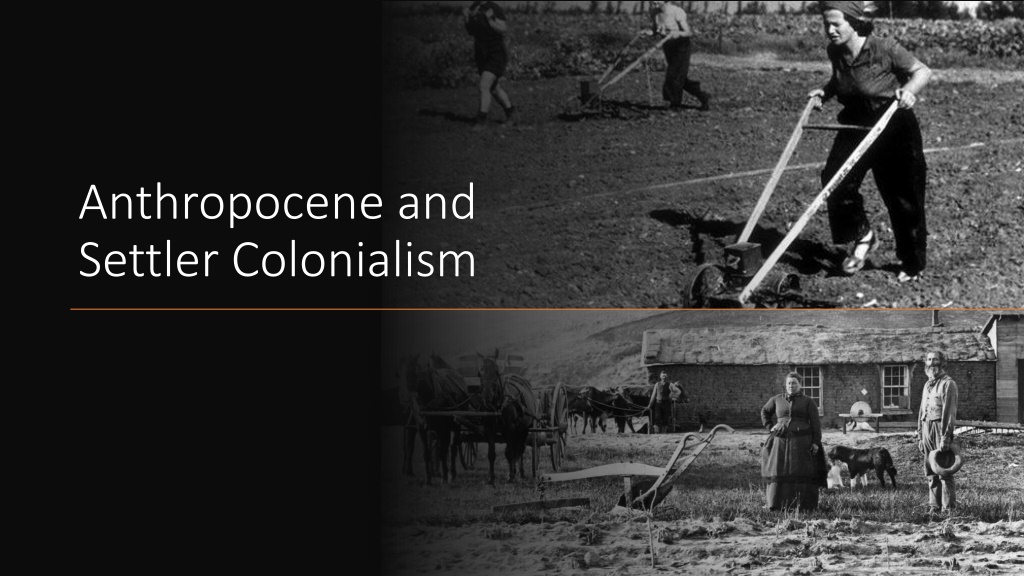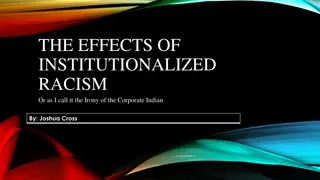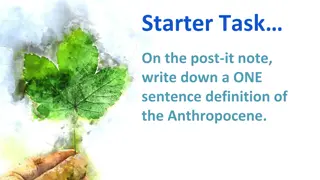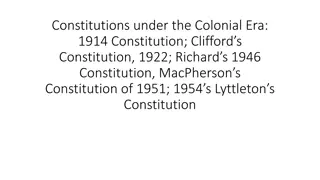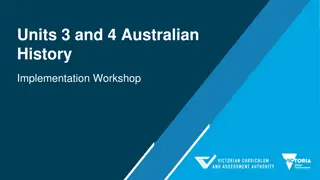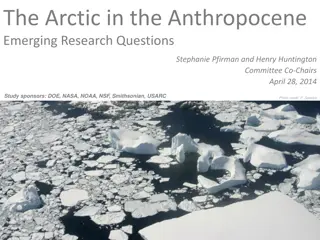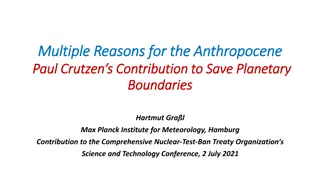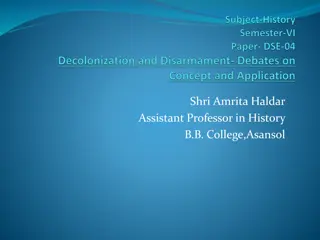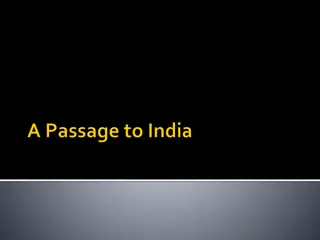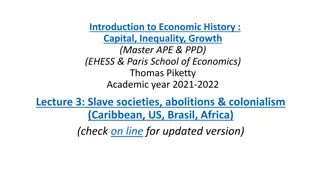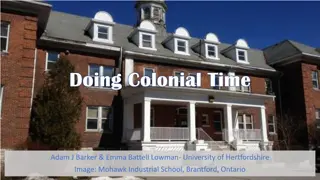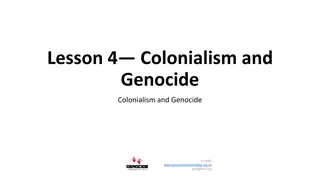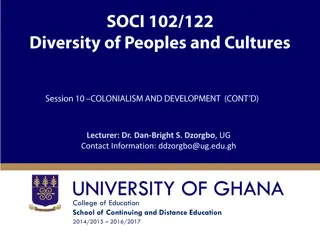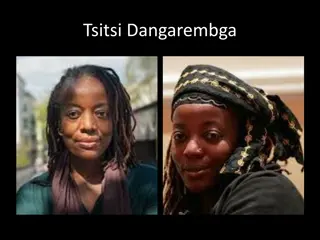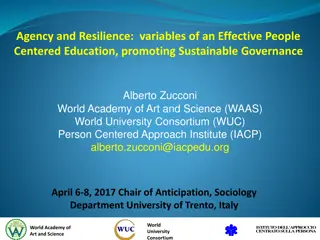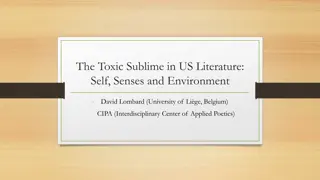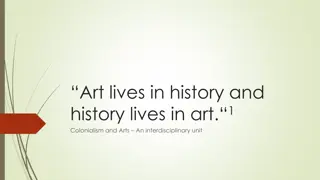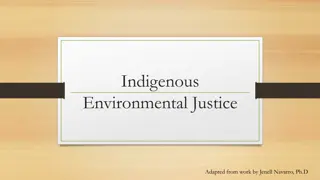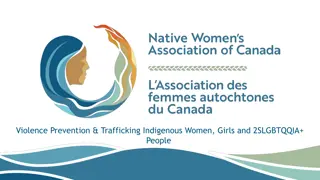Understanding Settler Colonialism and Its Impact in the Anthropocene
Settler colonialism, a structure of domination, aims to permanently transfer settlers to Indigenous lands, leading to ongoing dispossession and conflict. This form of colonialism disrupts Indigenous nationhoods, political practices, and sovereignties. The dispossession of Indigenous bodies and lands is a key strategy used to assert settler dominance and erase Indigenous presence. This deep-rooted process challenges Indigenous political orders and solidarities, making it difficult to combat settler governmentality. The destructive nature of settler colonialism is evident in the deliberate destruction and replacement of Indigenous ways of life, as seen in historical examples from around the world.
Download Presentation

Please find below an Image/Link to download the presentation.
The content on the website is provided AS IS for your information and personal use only. It may not be sold, licensed, or shared on other websites without obtaining consent from the author. Download presentation by click this link. If you encounter any issues during the download, it is possible that the publisher has removed the file from their server.
E N D
Presentation Transcript
Anthropocene and Settler Colonialism
When colonialism is discussed, it is usually franchise, rather than settler, colonialism that comes to mind. While closely connected, through flows of labour and goods, to say nothing of the colonial powers that rule them, the two formations also have distinct characteristics. Most importantly, if franchise colonial regimes rule the colonised through a mixture of military power, colonial administrators and collaborating local ruling classes, they do not try to permanently transfer citizens from the metropole to the colony, in order to establish a new colonial society on conquered lands. Settler colonial formations, on the other hand, do aim to do so, by transferring settlers hence the name onto Indigenous land. In terms of the former, think, for example, of British colonial rule in India or French colonial rule in Syria. On the other hand, the establishment of European societies in Argentina, Algeria, or Australia, are all relevant examples of the latter. Settlers settle. They (aim to) make colonised lands their permanent home and in the process enter into continuous and sustained conflict with the Indigenous populations, whom they (attempt to) dispossess, exploit and/or eliminate. This aspect of settler colonialism is often summarised in the words of Patrick Wolfe: The colonisers come to stay invasion is a structure not an event (Sai Englert, Settler Colonialism: An Introduction, Pluto Press, 2023, 5-6)
Settler colonialism as a structure of domination that is partly predicated on the ongoing dispossession of Indigenous peoples' lands and the forms of political authority and jurisdiction that govern our relationship to these lands [ It works] through the dispossession of Indigenous bodies from Indigenous lands and by impeding and systemically regulating the generative relationships and practices that create and maintain Indigenous nationhoods, political practices, sovereignties, and solidarities. The state- sanctioned murdering, assimilating, and disappearing of Indigenous bodies (asymmetrically distributed across genders) are, as the Mohawk scholar Audra Simpson says, a direct attack on Indigenous political orders because these bodies generate knowledge, political systems, and ways of being that contest the hegemony of settler governmentality and thus make dispossession all the more difficult to achieve (Glen Coulthard and Leanne Betasamosake Simpson Grounded Normativity / Place-Based Solidarity. American Quarterly, vol. 68, no. 2, 2016, 251-4)
Settler conialism destroys to replace. As Theodor Herzl, founding father of Zionism, observed in his allegorical manifesto/novel, If I wish to substitute a new building for an old one, I must demolish before I construct. In a kind of realization that took place half a century later, one-time deputy-mayor of West Jerusalem Meron Benvenisti recalled, As a member of a pioneering youth movement, I myself made the desert bloom by uprooting the ancient olive trees of al-Bassa to clear the ground for a banana grove, as required by the planned farming principles of my kibbutz, Rosh Haniqra. Renaming is central to the cadastral effacement/replacement of the Palestinian Arab presence that Benvenisti poignantly recounts. Comparably, though with reference to Australia, Tony Birch has charted the contradictory process whereby White residents sought to frustrate the (re-) renaming of Gariwerd back from the derivative Grampians that these hills had become in the wake of their original owners' forcible dispossession in the nineteenth century. (Patrick Wolfe, Settler colonialism and the elimination of the native, Journal of genocide research 8.4 (2006): 338-9)
In 1830, Congress passed the Indian Removal Act as a means of claiming and expanding u.s. territory by violently removing Native Peoples from our homelands to territories not our own. This act was designed to cut relationships Native Peoples had with the land by removing us, destroying our homes, our medicines, our crops, our livestock, and killing any who resisted. Since the passing of the Indian Removal Act, and u.s. expansion out west, the popular Wild West trope began, where settlers positioned themselves as saviors, and us as savages. [ ] On the other side of the world, our Palestinian Relatives are resisting similar violence and conditions, albeit under a different timeline of settler colonization; facilitated by the same people and their connected forces. Although Zionist colonization and the ethnic cleansing of Palestine began in the years preceding 1948, over 450 years past the colonization of the so-called americas, the brutality of continuing settler colonial violence and genocide are ongoing in both cases. [ ] When Palestine is free, we are all free. Although our Peoples come from different nations and geographies, the struggles against settler colonialism are the same. Not because we or our struggles are the same but because settler colonialists share playbooks (NDN Collective, Right of Return is Landback https://ndncollective.org/right-of-return-is-landback/)
This story was written in 1962. It was the first entrance of me to the reality of Israel [ ] We were living in Jerusalem, there were some small trees and some bushes and we wanted to liberate the trees from all this stuff around them. We were tired so we made a fire. Then I was thinking we will burn also the young trees! I created this story, which was about the question of repression. This bizarre student discovers that there was a village before the forest and the people are denying that there was a village. The Arab character, knowing that there was a village there, tries to evoke the memory of this village by putting fire on the forest in order that the remains, the ruins will be discovered. The question was not that you could build again the village, but don t deny that there was a village don t deny it. Open it and maybe you will avoid the fire that will come. I don t dare to say it, but in a prophetic way it made a point about the Palestinians coming back and speaking about their ruins, about their nakba. In 1962, this was a revelation (Tom Sperlinger A conversation with A.B. Yehoshua https://www.bristol.ac.uk/media- library/sites/english/migrated/documents/yehoshua.pdf)
While it is not wrong to interpret the forests in Yehoshua as allegories of a deeper Israeli culture of denial, we should also take its portrayal of nature seriously, as a literal representation of the changing material histories of forests and arboriculture in Israel/Palestine. Comparative analysis of the texts reveals that their forests are not just symbols of false memory, but responses to and critiques of the changing relationship between landscape and Israeli national identity over time (Hannah Boast, Planted Over The Past : Ideology and Ecology in Israel's National Eco-Imaginary, Green Letters 16.1 (2012): 46-58.48).
Questions: Darwish, Berdugo, Yehoshua Salih and Corry use the term settler-Nature to describe the practice of eliminating the native and their natural and ecological habitats, then discursively constructing the landscape as wasteland , bending and refining existing legal edifices, and finally redeeming the land through settlers technologies, ethics and hard work (389). How does Berdugo, Yehoshua, and Darwish all depict this process? Berdugo s article takes up the example of the KKL-JNF forests to show the connections between ecological transformation, land appropriation, and cultural and epistemic erasure. How does Yehoshua s short story both represent this process and its limits or failures? What kinds of formal techniques does he use to call the settler-Nature nexus into question? How does Mahmoud Darwish highlight the integrated relations between people, place or land, and thought? How do the kinds of relations Darwish highlight differ from those that Yehoshua s protagonist holds?
